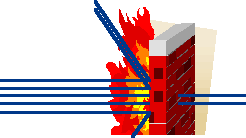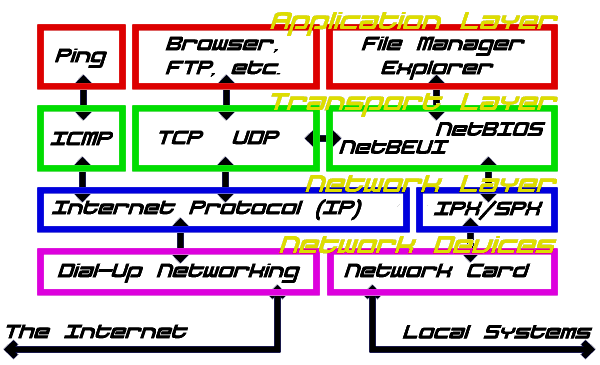 What is a firewall?
What is a firewall? What is a firewall?
What is a firewall?
| The Word | Location, Location, Location | Packet Filtering | Circuit Relay | Application Gateway | The Stack | References |
(This page is not intended to present a complete
description of all firewall functions, nor is it intended to sell
any product. It is meant only to convey a good basic concept of what
a firewall is to home users. If techno stuff is
totally mysterious to you, brace yourself for a little bit of
strange new terminology. I've tried to define terms and to use as
much plain English as possible, in hopes you'll find it
comprehensible. I invite anyone who can, to point out errors of
fact or important omissions.)
The term "fire wall" originally meant, and still means, a fireproof wall intended to prevent the spread of fire from one room or area of a building to another. The Internet is a volatile and unsafe environment when viewed from a computer-security perspective, therefore "firewall" is an excellent metaphor for network security.
In computer networking, the term firewall is
not merely descriptive of a general idea. It has come to mean
some very precise things.
The most important aspect of a firewall is that it is at the entry point of the networked system it protects. In the case of Packet Filtering, it is at the lowest level, or "layer" in the hierarchy ("stack") of network processes, called the Network Layer or the Internet Layer. This means essentially that the firewall is the first program or process that receives and handles incoming network traffic, and it is the last program to handle outgoing traffic.
The logic is simple: a firewall must be positioned to control all incoming and outgoing traffic. If some other program has that control, there is no firewall.
So -- what do firewalls do?
All Internet traffic travels in the form of packets. A packet is a quantity of data of limited size, kept small for easy handling. When larger amounts of continuous data must be sent, it is broken up into numbered packets for transmission and reassembled at the receiving end. All your file downloads, Web page retrievals, emails -- all these Internet communications always occur in packets.
A packet is a series of digital numbers basically, which conveys these things:
In packet filtering, only the protocol and the address information of each packet is examined. Its contents and context (it relation to other packets and to the intended application) are ignored. The firewall pays no attention to applications on the host or local network and it "knows" nothing about the sources of incoming data.
Filtering consists of examining incoming or outgoing packets and allowing or disallowing their transmission or acceptance on the basis of a set of configurable rules, called policies.
Packet filtering policies may be based upon any of the following:
This is the original and most basic type of firewall.
Packet filtering alone is very effective as far as it goes but it is not foolproof security. It can potentially block all traffic, which in a sense is absolute security. But for any useful networking to occur, it must of course allow some packets to pass. It weaknesses are:
An advantage of packet filtering is its relative simplicity
and ease of implementation.
Also called a "Circuit Level Gateway," this is a firewall approach that validates connections before allowing data to be exchanged.
What this means is that the firewall doesn't simply allow or disallow packets but also determines whether the connection between both ends is valid according to configurable rules, then opens a session and permits traffic only from the allowed source and possibly only for a limited period of time. Whether a connection is valid may for examples be based upon:
Every session of data exchange is validated and monitored and all traffic is disallowed unless a session is open.
Circuit Level Filtering takes control a step further than a Packet Filter. Among the advantages of a circuit relay is that it can make up for the shortcomings of the ultra-simple and exploitable UDP protocol, wherein the source address is never validated as a function of the protocol. IP spoofing can be rendered much more difficult.
A disadvantage is that Circuit Level Filtering operates at the
Transport Layer and may require substantial
modification of the programming which normally provides transport
functions (e.g. Winsock).
In this approach, the firewall goes still further in its regulation of traffic.
The Application Level Gateway acts as a proxy for applications, performing all data exchanges with the remote system in their behalf. This can render a computer behind the firewall all but invisible to the remote system.
It can allow or disallow traffic according to very specific rules, for instance permitting some commands to a server but not others, limiting file access to certain types, varying rules according to authenticated users and so forth. This type of firewall may also perform very detailed logging of traffic and monitoring of events on the host system, and can often be instructed to sound alarms or notify an operator under defined conditions.
Application-level gateways are generally regarded as the most secure type of firewall. They certainly have the most sophisticated capabilities.
A disadvantage is that setup may be very complex, requiring detailed attention to the individual applications that use the gateway.
An application gateway is normally implemented on a separate computer on the network whose primary function is to provide proxy service.
As you can see, all firewalls regardless of type have one very important thing in common: they receive, inspect and make decisions about all incoming data before it reaches other parts of the system or network. That means they handle packets and they are strategically placed at the entry point to the system or network the firewall is intended to protect. They usually regulate outgoing data as well. The types and capabilities of firewalls are defined essentially by:
A rough approximation of the "stack" in a typical Win9x machine on a household LAN and with dial-up:

http://elias.decus.ch/presentations/ge_19970415_av/TSLD011.HTM
Generic Firewall Functions
A straightforward, simple outline of firewall functions, part of
a sales presentation for the Alta Vista Firewall.
http://www.ukiahsoft.com/securitywp.html
NetRoad FireWALL White Paper
A sales piece for the NetRoad FireWALL from Ukiah Software, Inc.,
containing a Firewall Primer with excellent descriptions of
firewall types. More technical but it defines terms and is well
written.
http://www.infosecuritymag.com/fire.htm
Fire in the Hole
An August 1998 article by Edward Skoudis. Written for savvy
readers but with lots of good basic information about firewalls
and the then-current state of the firewall art.
http://mmm.wiwi.hu-berlin.de/IMI/s_firewalls.html
Network Security and Firewalls
Another good reference, which though highly technical explains
more about what those "layers" are and how security
works in each layer.